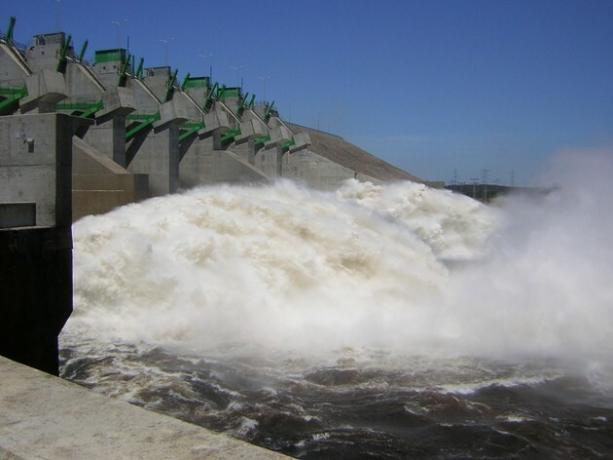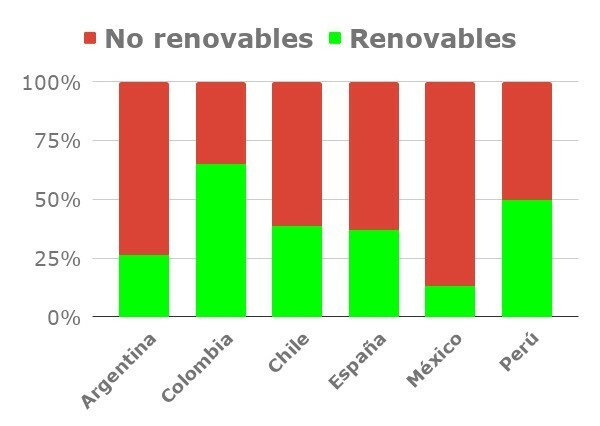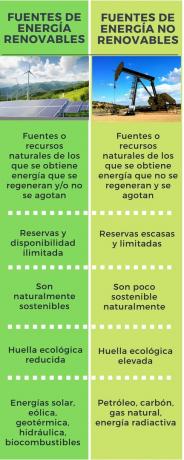Difference between renewable energy and non-renewable energy
When you talk about renewable or non-renewable energy we refer to the energy sources from which they arise. The renewable energy sources They are those that do not run out or are renewed in a relatively short time; the Non-renewable energy sources They are those that run out with use or their regeneration is much slower.
Let us remember that energy, lthe ability to do work and / or produce heat, it is neither created nor destroyed but transformed. The different forms in which energy is presented are best known from the sources of origin: energy solar is that which comes from the sun, wind energy is the energy generated by the movement of the air, and so on successively.
| Renewable energy sources | Non-renewable energy sources | |
|---|---|---|
| Definition | Energy sources that are not depleted or regenerate quickly | Sources of obtaining energy that are depleted and not renewed |
| Bookings | Unlimited | Limited |
| Sustainability | Elevated | Short |
| Ecological footprint | Reduced | Augmented |
| Examples | Solar, wind, geothermal, hydraulic, biomass | Oil, coal, gas, radioactive elements |
Definition of renewable sources of energy

Renewable energy is that from sources that are not depleted with use or that are regenerated in a short term. Their use is sustainable in nature and they are found in large quantities. Obtaining and distributing them represent a technological, economic and cultural challenge.
Examples of renewable energy sources
Renewable energy resources offer cleaner alternatives for generating energy.
Sun
Solar energy is the radiant energy from the nuclear fusion of the elements that make up the sun: hydrogen and helium. The sun is a free and inexhaustible source of energy. Plants naturally capture solar energy in the process of photosynthesis. On the other hand, solar radiation is the energy engine that heats the earth's surface, generates winds and maintains the water cycle.
Currently there are two technologies for the use of solar energy by human beings:
- Photovoltaic technology: converts solar energy into electrical energy through silicon cells that react with light.
- Solar thermal technology: solar collectors use solar energy to heat fluids.
Wind
Wind energy comes from the wind, the movement of air that occurs as a result of temperature changes on the earth's surface.
Wind has been used as a power generator since ancient times. The sails of ships in navigation, windmills to grind grain and transport water are examples of the application of the wind to produce work.
More recently, some countries are basing electrical power generation through wind turbines. These huge devices are designed and built to more economically capture the wind with higher speed. Wind farms are large-scale turbine installations.
Water
This is a natural resource available in regions with currents or rivers with changes in height. The water falls on wheels or mechanical motors that generate electricity. Hydropower represents the largest percentage of all renewable energy sources.
However, the construction of hydroelectric plants and dams have a great environmental impact: flooding large areas of land, displacement of populations and alteration of the environment in a way irreversible.
Biomass
Biomass is the organic matter generated by biological processes. All those fuels that are preceded by the prefix Bio are obtained from biomass: bioethanol, biogas. The sources of biomass are wood and the remains of tree cuts, animal excrement, the remains of the processing of fruits and vegetables in the food industry, among others.
The heat of the Earth
The internal heat of the Earth can be harnessed as geothermal energy. Water vapor is used to generate electricity and heating in industries.
However, most of the areas with potential for extraction are in protected areas.
Sea waves
Waves are the result of the movement of water in the oceans by the action of the wind. In Denmark, a technology is being developed that makes it possible to take advantage of the movement of waves to generate electricity: Wave star.
Hydrogen cells
Hydrogen is one of the most abundant elements in the Universe. It can be used to start vehicles, heating and electricity.
You may be interested in knowing the Types of renewable energies.
Definition of non-renewable sources of energy

Non-renewable energy sources are those resources that cannot be recovered in their original form after extracting energy from them.
Examples of non-renewable energy sources
Fossil fuels
The energy contained in fossil fuels was originally obtained from the sun, through the process of photosynthesis. In their time, plants and animals from millions of years ago died and were deposited, then covered with layers of soil and rocks. The immense pressure to which these organic remains were subjected contributed to the transformation into what we now know as fossil fuels. Examples of them are oil and its derivatives, coal and gas.
These energy sources are pollutants and generators of greenhouse gases, which cause the effect of global warming.
Nuclear plants
The use of radioactive material to generate electricity in nuclear plants implies enormous environmental damage and the consumption of non-renewable resources. Radioactive uranium generates harmful waste such as thorium-230, radium-226, radon-222, lead-210, and polonium-210, which are inconvenient to store.
Sources of electricity generation in Latin America and Spain

Modern civilization requires energy to maintain a high standard of lifestyle. The development of an industrialized society is highly dependent on an adequate supply of energy. However, if we continue to abuse resources in an unsustainable way, we risk compromising the future of humanity.
In Latin America, only Colombia and Peru depend 50% or more on electricity from renewable sources, mostly hydroelectric. It is up to us as citizens to demand from our leaders a turn in the direction of economic development with environmental sustainability.
You may be interested in knowing more about:
- Renewable and non-renewable resources.
- Advantages and disadvantages of solar energy.
- Types of energy
Comparative infographic between renewable and non-renewable energies


Doctor in Biochemistry from the Venezuelan Institute of Scientific Research (IVIC), with a degree in Bioanalysis from the Central University of Venezuela.



